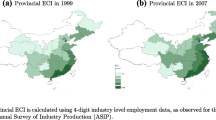Abstract
This paper reports an analysis of the determinants of the level and changes in Polish industrial concentration in the early post-transition era. In particular, the relative effects of foreign and state ownership are examined. The empirical evidence is based on a panel of 144 Polish manufacturing industries over the period 1989–1993. The results suggest that both state and foreign ownership have a significant impact on industry concentration and this relationship is U-shaped. Minimum efficient scale is found to be the only other factor to impact on industry concentration.
Similar content being viewed by others
Notes
Sutton (1991) argues that research and development (R&D) and advertising expenditures are endogenous sunk costs that serve as strategic barriers to entry, which consequently lead to higher concentration. Sutton suggests using R&D and advertising intensity to distinguish between industries when estimating concentration models rather than estimating a model for all industries. Unfortunately, R&D and advertising data are unavailable and so we do not adopt the approach suggested by Sutton.
According to the Polish classification system used by 1993, the manufacturing sector is divided into 24 two-digit branches, and further into 170 three-digit industries. The codes used are slightly different from the published SIC codes but for the majority of industries it is possible to find a match on the basis of the description of the product of a given industry.
These industries are not named because GUS regards the information as commercially sensitive.
The price index available is at a level more aggregated than the 3-digit classification we used throughout.
References
Aitken BJ, Harrison AE (1999) Do domestic firms benefit from direct foreign investment? Evidence from Venezuela. Am Econ Rev 89:605–618
Arellano M, Bond S (1991) Some tests of specification for panel data: Monte Carlo evidence and an application to employment equations. Rev Econ Stud 58:277–298
Battacharya M, Bloch H (2000) The dynamics of industrial concentration in Australian manufacturing. Int J Industr Org 18:1181–1199
Blomstrom M (1986) Multinationals and market structure in Mexico. World Develop 14:523–530
Caves RE (1996) Multinational enterprise and economic analysis. Cambridge University Press, Cambridge
Chou TC (1986) Concentration, profitability and trade in a simultaneous equations analysis: the case of Taiwan. J Industr Econ 34:429–443
Co CY (2001) Trade, foreign direct investment and industry performance. Int J Industr Org 19:163–183
Conyon MJ, Girma S, Thompson S, Wright M (2002) The productivity and wage effects of foreign acquisition in the United Kingdom. J Industr Econ 50:85–102
Driffield N (2001) Inward investment, industry concentration and the speed of adjustment. Weltwirtschaftliches Archiv 137:193–214
Evans WN, Froeb LM, Werden GJ (1993) Endogeneity in the concentration–price relationship: causes, consequences, and cures. J Industr Econ 41:431–438
Geroski PA (1995) What do we know about entry? Int J Industr Org 13:421–440
Ghemawat P, Kennedy RE (1999) Competitive shocks and industrial structure: the case of Polish manufacturing. Int J Industr Org 17:847–867
Klepper S, Graddy E (1990) The evolution of new industries and the determinants of market structure. Rand J Industr Econ 21:27–44
Levy D (1985) Specifying the dynamics of industry concentration. J Industr Econ 34:55–68
Oehlert GW (1992) A note on the delta method. Am Statist 46:27–29
Ratnayake R (1999) Industry concentration and competition: New Zealand experience. Int J Industr Org 17:1041–1057
Slay B (1995) Industrial demonopolization and competition policy in Poland and Hungary. Econ Transit 3:479–504
Sutton J (1991) Sunk costs and market structure: price competition, advertising, and the evolution of concentration. MIT Press, Cambridge
Symeonidis G (2000) Price competition, non-price competition and market structure: theory and evidence from the UK. Economica 47:437–456
Teece DJ (1985) Multinational enterprise, internal governance and industrial organization. Am Econ Rev 75:233–238
Windmeijer F (2000) A finite sample correction for the variance of linear two-step GMM estimators. Working Paper 00/19, Institute for Fiscal Studies, London
Author information
Authors and Affiliations
Corresponding author
Data Appendix
Data Appendix
1.1 Definition of variables
HI—the Hirschman–Herfindahl concentration index (equal to the sum of squared market shares of all the firms in the industry), where the share of each firm is expressed in terms of sales.
MES—minimum efficient scale is the average size of enterprise contained in the upper 50th percentile of industry sales. It is expressed as a proportion by dividing through by industry sales.
SIZE—market size measured by industry sales (in millions of Polish zloty) and deflated by the 1988 price index.Footnote 5
INTANG—the ratio of intangible assets (such as patents, goodwill, brand name) to total assets.
PCM—price-cost margin is defined as (sales-cost)/sales, where cost includes all costs such as intermediate inputs and energy, not just wage bill.
CAPR—The industry entry capital requirements calculated as MES multiplied by the capital stock-sales ratio.
STATE_NUM—the ratio of state-owned firms to the total number of firms in a given industry.
STATE_SHARE—the ratio of output produced by state-owned firms to total industry output.
FOREIGN_NUM—the ratio of foreign-owned firms to the total number of firms in a given industry.
FOREIGN_SHARE—the ratio of output produced by foreign-owned firms to total industry output.
Rights and permissions
About this article
Cite this article
Amess, K., Roberts, B.M. The impact of foreign and state ownership on post-transition industrial concentration: the case of Polish manufacturing. Econ Change 38, 211–225 (2005). https://doi.org/10.1007/s10644-006-9003-z
Received:
Accepted:
Published:
Issue Date:
DOI: https://doi.org/10.1007/s10644-006-9003-z




